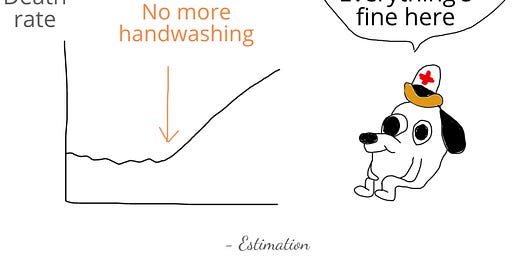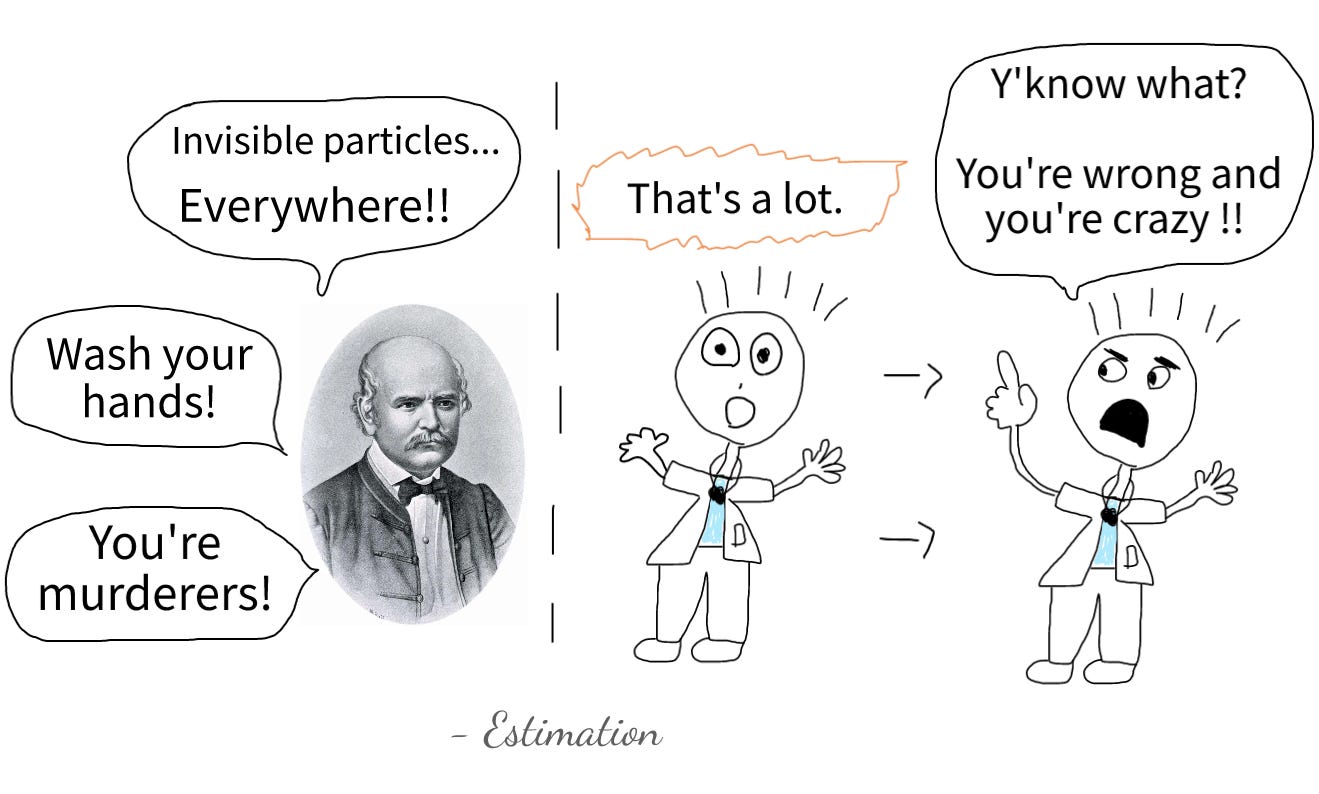The Blasphemy of Washing Your Hands
How incorrect beliefs persist in the face of new contradictory evidence
Welcome to Estimation! I write about insights gleaned from the origin stories of products, places, movements, and beliefs.
Join hundreds of other readers gaining insights from origin stories by subscribing below!
You can check out my other articles too :)
We love to see ourselves as rational.
We see things as they are. We make great decisions. It goes without saying that our political views are the most sensible.
Umm yeah… Sadly we’re flat out wrong about our rationality. Almost as wrong as the 30% of our species who think it’s perfectly acceptable to hang toilet paper “under”.
As in the case of “team under,” we view the world through biased and distorted lenses. Understanding how biases influence us is critical for truth-seeking and good decision making.
One example is Belief Perseverance - where we get stuck to our initial beliefs, even after receiving new evidence that contradicts our views.
Take hand washing as an example. It seems obvious today that hand washing and good hygiene go hand in hand (haha..), but this wasn’t always the case.
The origins of hand washing for hygiene tells us a lot about the rigidity of beliefs, as well as the devastating consequences that can follow.
Discovery of hand washing for hygiene
Ignaz Semmelweis, a.k.a the father of hand washing, was the chief doctor of the Vienna General Hospital in the mid-19th century.
There were two maternity clinics at his hospital. Childbed fever was a major killer at the time, and the First Clinic had a mortality rate 2.5x that of the Second Clinic.
As a result, desperate women begged not to be admitted to the First Clinic. Some even preferred to give birth on the streets outside - surprisingly, these women had lower incidences of childbed fever than those in the First Clinic.
Semmelweis was losing his shit. He obsessed about the First Clinic’s performance, and experimented for years to account for the culprit variable. He even went so far as to run an A/B test with priests ringing a bell near pregnant women…
His breakthrough came in 1847 when one of his doctors died from symptoms similar to childbed fever, after accidentally being poked with a scalpel during a post-mortem.
Suddenly, it clicked. Medical students in the First Clinic also worked on autopsies, whereas the midwives in the Second Clinic did not. Semmelweis proposed that “particles” on the doctors hands from dead bodies were causing childbed fever.
He instituted mandatory chlorine hand washing before seeing patients, and saw astonishing results. The mortality rate in the First Clinic fell from 18.3% to 2.2% over the course of two months.
The tragic consequences for Semmelweis
Semmelweis’ hypothesis of uncleanliness being the cause of childbed fever was radical at the time.
His findings defied established medical opinion, which argued that the disease was caused by “internal personal imbalances”, and that bloodlettings were the cure. There was no scientific basis at the time to suggest that germs or ‘invisible particles’ were a thing.
Doctors felt attacked, since his claims implied that they were at fault for patient deaths. Calling them a walking petri-dish challenged their world view in a disturbing way.
It’s safe to say he got shut down pretty hard.
Semmelweis was fired for political reasons and then harassed by the medical community until he left for Hungary. He joined a hospital in Budapest where childbed fever was rife. After introducing cleanliness procedures, he once again virtually eliminated childbed fever. Nonetheless, he continued to be ignored and ridiculed by the medical community.
A few years later, the increasingly vocal Semmelweis was committed to a mental asylum after allegedly having a nervous breakdown. There, he was beaten by the guards and died from an infected wound caused by the assault.
Meanwhile, Semmelweis’ successor at his Budapest hospital removed his cleanliness policies. Almost immediately, mortality rates increased 6x. The physicians said nothing, and there were no inquiries or protests.
Semmelweis’ findings only earned widespread acceptance years after his death when germ theory was confirmed, giving his findings a solid theoretical explanation.
The Semmelweis Effect and the perseverance of belief
One type of belief perseverance is the aptly named Semmelweis Effect - our “reflex-like” tendency to reject new evidence when it contradicts established norms and beliefs.
This intuitively makes sense. If we’re presented with an argument that makes us look bad, challenges our core beliefs, or has costly ramifications, our first instinct is to justify how the argument is wrong.
Old beliefs may even be strengthened when presented with new evidence debunking them - a phenomenon hypothesized as the ‘Backfire Effect.’
My take is that belief perseverance is ultimately driven by the core human desire for life to be predictable. We want stability, but when our strongest views are threatened we end up with a mindblowing level of chaos and uncertainty.
How belief perseverance plays out today
The vast majority of US voters are unlikely to change their perception of the other party or their beliefs about society’s most polarizing issues, no matter how compelling any new evidence may be.
Our deepest beliefs slowly become our identity. When our core views are challenged, our identity itself is called into question.
If my political views are ‘wrong’, then what is life? Who even am I?
Rather than entertain this possibility, it’s far easier to simply double down on our existing beliefs.
In the most extreme cases of belief perseverance, there are still people out there who believe that the Earth is flat.
Yup - wild how the universe did that ^^^
It’s not just our beliefs about the external world that we get stuck to. Belief perseverance also plays out with self-image, in both positive and negative ways.
A startup I founded didn’t work out - we had a painful ending, having to lay off the entire team and tell investors we’d lost their money. As I have pretty strong conviction in my abilities, I didn’t take it too personally or let it break me. I know that shit happens, so I got back up and kept plugging away (after a brief rest period to regain my sanity…).
On the other hand, deep-rooted body image issues have meant that even though I’m in decent shape today, I have a tendency to view myself in an overly-negative way due to old beliefs from childhood.
We all live with belief perseverance in one way or another. How is this affecting the way you think about the world?
Let me know in the comments below or by hitting reply :)
- Amol
If you liked this piece, make sure to subscribe by adding your email below!









